Injury Prevention Esports: Comprehensive Guide for Players
Updated On: October 24, 2025 by Aaron Connolly
Understanding Injury Risks in Esports
Esports athletes deal with some pretty unique physical challenges—stuff that traditional sports medicine is just now starting to notice.
During competitions, pro players crank out more than 300 precise movements per minute. No wonder repetitive strain injuries hit up to half of all competitive gamers.
Common Injuries Among Esports Athletes
Musculoskeletal problems keep showing up in esports. Neck and back pain? It’s almost a rite of passage, with nearly half of competitive gamers feeling it at some point.
“Text neck” syndrome is everywhere now. Players lean forward towards screens for hours, and this can lead to early disc problems and pinched nerves.
Hand and wrist injuries are another big headache—about 30% of esports athletes deal with them. Carpal tunnel syndrome is the worst offender, but you also see:
- Cubital tunnel syndrome
- De Quervain’s tendinopathy
- “Gamer’s thumb” from controllers
- Tennis elbow from relentless clicking
Eye-related issues are finally getting some real attention. The International Olympic Committee even recognizes them as sports injuries now. Digital eye strain is rampant—dryness, fatigue, blurry vision, you name it.
Sleep disorders really mess with performance. Blue light from screens throws off circadian rhythms, and a lot of players complain about “screen insomnia” after late-night grind sessions.
Nutritional problems tend to fly under the radar. Long gaming sessions and bad eating habits can lead to weight gain and those awful energy crashes right when you need focus.
Factors Contributing to Esports Injuries
Training volume stands out as the main culprit. Pro esports athletes usually train at least 5 hours a day, and some teams go all-in for 12 hours when prepping for tournaments.
Amateur players often just copy the pros’ schedules without learning anything about injury prevention. That’s a recipe for disaster.
Poor ergonomics make injury risks skyrocket. You’ll see players sitting on chairs with no lumbar support, monitors set at weird heights, and keyboards or mice that just don’t fit right.
A lot of setups look cool but aren’t exactly designed with health in mind.
Repetitive movements at intense speeds cause microtrauma. Elite players repeat precise actions hundreds of times every minute, and it’s not that different from what musicians deal with.
Platform differences matter, too. Console players and PC gamers develop different injuries, while VR users have to deal with stuff like “cybersickness” and eye moisture issues.
Lack of recovery time really hurts. Esports seasons never seem to end, so players rarely get a real break between competitions.
Differences Between Professional and Amateur Players
Professional esports athletes might have better medical support, but they also run into more injuries. Sports medicine specialists and ergonomic assessments are available, but the pressure to compete means a lot of folks just play through the pain.
Most pro teams follow strict training schedules. Team physiotherapists check in on players regularly, and pre-participation medical screening is becoming the norm.
Amateur players have a whole different set of problems. They usually don’t have access to good medical care or any education about injury prevention.
Most don’t even spot the early warning signs of overuse injuries.
Amateurs often use cheap or old equipment for way too long. They’ll ignore pain and keep playing, and without team support, they don’t get help until things get pretty bad.
Age differences play a part, too. Pros are mostly in that 18-25 range, but amateurs can be any age. Older players have extra risks—existing health issues and slower recovery times.
Training intensity jumps all over the place between the two groups. Pros stick to periodised plans, while amateurs might go all-out for hours and then not play for days. That kind of inconsistency actually makes injuries more likely.
Types of Esports Injuries
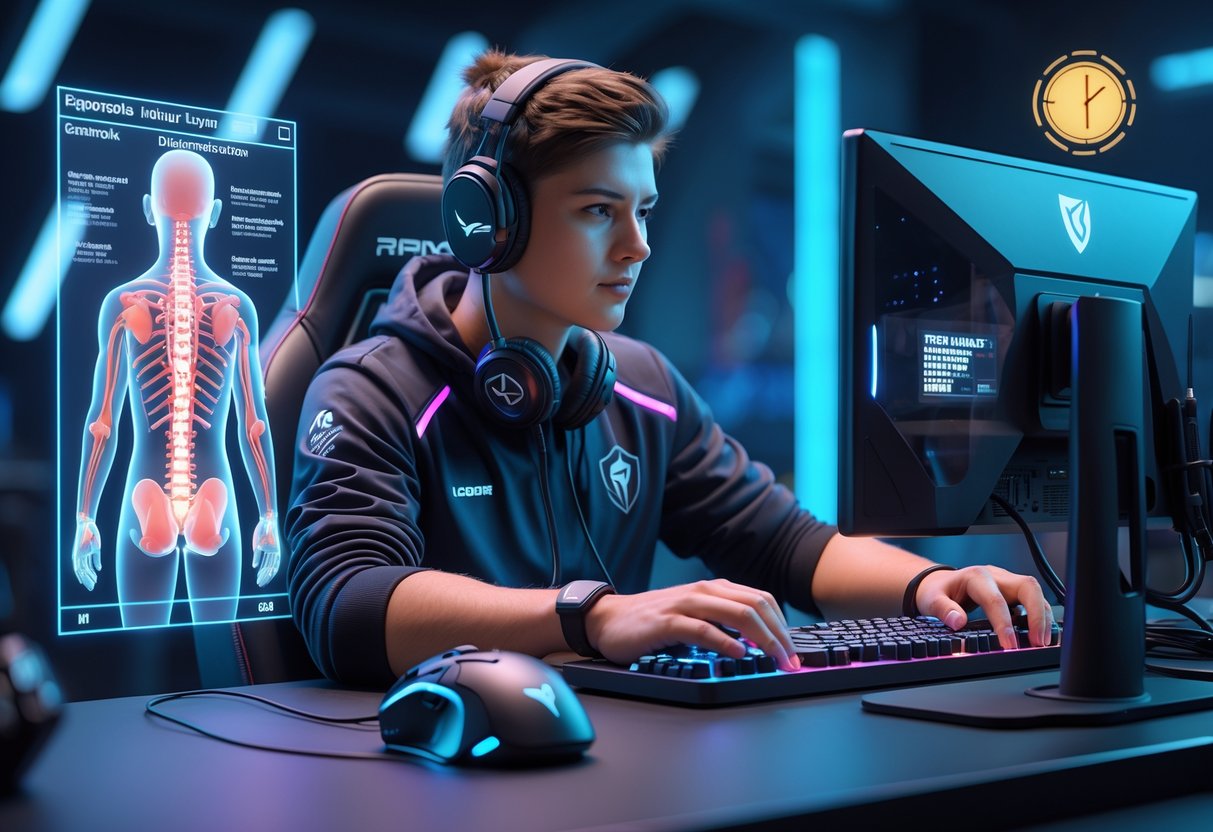
Professional gamers deal with a bunch of physical issues from those marathon gaming sessions. Most injuries hit the hands, wrists, and arms because of all the repetitive movements and not-so-great posture.
Repetitive Strain Injuries (RSI)
RSI pops up when we do the same motions over and over. In esports, players can make more than 300 precise moves every minute during matches.
These injuries sneak up on you. All that clicking, pressing, and controller action causes tiny tears in muscles and tendons.
Common RSI symptoms:
- Aching or burning in hands and arms
- Stiff fingers and wrists
- Weak grip on controllers or mice
- Pain that ramps up during gaming
RSI hits almost 40% of pro players. Longer sessions and bad ergonomics just make it worse.
Catching RSI early is key. Taking breaks, stretching, and fixing your setup can keep things from getting out of hand.
Carpal Tunnel Syndrome
Carpal tunnel syndrome kicks in when nerves in the wrist get squeezed. The carpal tunnel is a tight spot in your wrist that protects the main nerve running to your hand.
Gamers often bend their wrists at weird angles, putting pressure on the median nerve. That leads to numbness, tingling, and pain.
Watch for these signs:
- Tingling in your thumb, index, and middle fingers
- Numbness that wakes you up at night
- Trouble gripping small stuff
- Weakness in your thumb
Pro gamers get carpal tunnel more than office workers do. Up to 30% of competitive players training for hours every day deal with it.
Treatment can mean anything from wrist splints to surgery if things get really bad. Most players dodge carpal tunnel by keeping wrists straight and taking breaks.
Gamer’s Thumb and Hand Injuries
Gamer’s thumb is basically tendinitis around the thumb joint. Console players who use controllers for hours are the ones who get hit hardest.
It causes pain at the thumb base that can stretch into the wrist. Even simple stuff like gripping or making a fist hurts.
Other hand injuries from gaming:
- Trigger finger—fingers get stuck bent
- Thumb sprains—from aggressive controller use
- Finger tendinitis—inflamed finger tendons
- Joint stiffness—less movement in fingers
Mobile gamers have their own problems from all the tapping and swiping. Those motions strain different muscles compared to traditional gaming.
Hand injuries usually respond to rest and anti-inflammatories. These days, a lot of pro teams bring in physiotherapists to help prevent and treat these issues.
Posture and Musculoskeletal Health
Bad posture during long gaming sessions can really mess with your back and neck. These problems show up after holding the same position for hours, building up muscle tension and long-term aches.
Impact of Poor Posture on Back and Neck
Poor posture causes problems fast. Slouching or craning your neck towards the screen strains your spine way more than you’d think.
That forward head position is a killer. When you lean towards your monitor, your head pushes out a few inches past your shoulders.
Typical posture issues:
- Rounded shoulders from hunching
- Forward head straining neck muscles
- Curved spine from slouching
- Tilted pelvis if your chair’s too high or low
These positions mess with muscle balance. Chest muscles tighten up while back muscles get weak and overstretched.
Your head weighs about 4.5-5.5 kg. Push it forward, and your neck muscles work overtime.
Heads up: Most players don’t even notice until the pain gets bad.
Bad posture also shrinks your lung capacity. Slouching squeezes your chest, so breathing becomes less efficient during matches.
Neck Pain and Back Pain Prevention
Setting up your gaming station the right way stops most neck and back pain before it starts.
Chair height should let your feet rest flat on the floor, with thighs parallel.
Monitor placement is huge. The top of your screen should be at eye level or a bit lower to keep your neck neutral.
Key setup tips:
- Monitor: 50-70 cm from your eyes
- Keyboard: Elbows at 90 degrees
- Mouse: Same height as keyboard
- Chair: Supports your spine’s natural curve
Move around every 30-45 minutes. Even standing for a couple of minutes helps reset your posture.
Strengthen weak muscles with upper back exercises—stuff like rows and reverse flies. These fight against the chest muscles pulling you forward.
Keep neck stretches gentle. Turn your head left and right, then tilt each ear towards your shoulder.
Pro tip: Set hourly reminders to check your posture and take quick breaks.
Muscle Tension and Musculoskeletal Problems
Muscle tension sneaks up during those long sessions. Neck, shoulders, and upper back muscles work nonstop to hold awkward positions.
When muscles contract and stay tight, blood flow drops. That’s how you get trigger points—knots that send pain all over your upper body.
Common tension spots:
- Trapezius (neck/shoulders)
- Levator scapulae (neck to shoulder blade)
- Suboccipital muscles (base of skull)
- Rhomboids (between shoulder blades)
Heat therapy helps. Try a warm compress for 15-20 minutes after gaming.
Foam rollers or massage tools work wonders on those knots—focus on your upper back between the shoulder blades.
Progressive muscle relaxation helps you find and release tight spots. Tense a muscle group for five seconds, then let go and notice the difference.
Stretching for gamers should target overused muscles. Doorway chest stretches are great for opening up tight pecs from hunching.
If pain sticks around for more than a few days or messes with your sleep, it’s time to see a pro.
Eye Health and Digital Fatigue
Pro esports athletes easily spend 5-8 hours glued to screens every day. That’s a recipe for vision problems that can end careers if you’re not careful.
Digital eye strain hits almost 87% of young gamers. Staring at screens for hours leads to dry eyes, headaches, and focus issues that wreck performance.
Digital Eye Strain Risks
Digital eye strain just hits esports players harder. We’re talking dry eyes, blurry vision, headaches—the usual, but way more intense after marathon sessions.
Blue light from screens messes with your sleep, too. That’s a real problem during late-night tournaments.
Watch for these symptoms:
- Eye fatigue after a couple hours
- Dry, irritated eyes
- Blurry or double vision
- Neck and shoulder tension
- Trouble shifting focus from screen to distance
Competitive players pull off over 300 precise movements per minute, which keeps eye muscles working non-stop.
LED backlighting in gaming monitors pumps out a ton of blue light. Over time, that can damage your retinas.
Quick fix: Try screen glasses with blue light filters during practice. Plenty of pros swear these make those 8-hour training days way easier on the eyes.
Eye Fatigue and Focus Issues
When your eyes get tired, your reaction times and decision-making tank. That sharp focus you need for split-second plays? Gone.
The 20-20-20 rule is nice for casual gaming, but it’s not really practical during matches. We need better strategies.
What works for gamers:
- Blink on purpose every few minutes to keep eyes moist
- Adjust monitor brightness to match your room lighting
- Keep screens 50-70 cm from your face
- Use artificial tears made for computer users
A lot of pro teams now bring vision specialists on board. They regularly check players’ visual sharpness, eye alignment, and focus speed.
Heads up: One League of Legends pro had to retire at 26 because of chronic eye problems after years of intense screen time with no prevention.
If you’re serious about competing, look into oculomotor performance training. Eye exercises can boost tracking speed and peripheral vision—both are game-changers in esports.
Ergonomics in Esports
If you set up your gaming space properly, you can avoid most esports injuries. You’ll save your neck, back, wrists, and even your eyes from unnecessary strain.
Just by positioning your equipment right and sitting with good posture, you might dodge up to 80% of gaming pain.
Setting Up Ergonomic Gaming Equipment
Let’s start with your monitor. It really sets the stage for everything else.
Put your screen 50-70cm from your face. Make sure the top third of the monitor lines up with your eyes.
That’s how you prevent that dreaded forward head posture, the sort that leads to “text neck.” If you use more than one screen, keep the main one right in front of you.
Don’t ignore your keyboard and mouse. They matter just as much.
Keep them both at elbow height. Your arms should make a 90-degree angle.
Try to keep your wrists straight while typing or clicking. Some gaming keyboards with wrist rests can really help during those marathon sessions.
Lighting is a big deal for your eyes. Set your monitor perpendicular to any windows, so you don’t get blasted with glare.
Add some ambient light behind your screen to soften the contrast. A lot of pros actually use bias lighting strips for this very reason.
| Equipment | Optimal Position | Common Mistake |
|---|---|---|
| Monitor | Top third at eye level | Too low, causing neck strain |
| Keyboard | Elbow height, wrists straight | Too high, causing wrist pain |
| Mouse | Same level as keyboard | Too far away, causing shoulder tension |
| Lighting | Behind screen, no glare | Direct overhead lighting |
Adopting Correct Sitting Posture
Your chair is the foundation of good posture. Adjust the seat so your feet rest flat on the floor, and your thighs stay parallel to the ground.
Push your lower back into the chair’s lumbar support. Many gaming chairs come with adjustable lumbar pillows, which is honestly a lifesaver.
Keep your shoulders relaxed and stacked over your hips. That’s how you avoid the back pain that plagues so many esports athletes.
Try not to lean forward, even when you’re in the heat of the moment. Slouching sneaks up on you when you’re focused.
Change up your position regularly. Shift your weight every 20-30 minutes, and stand up for a couple minutes each hour.
Some top teams now add “posture breaks” to their training. These little breaks keep your body happy and your game sharp.
Warning: If you game for more than two hours without a break, your risk of injury goes way up—doesn’t matter how ergonomic your setup is.
Physical Exercise for Injury Prevention
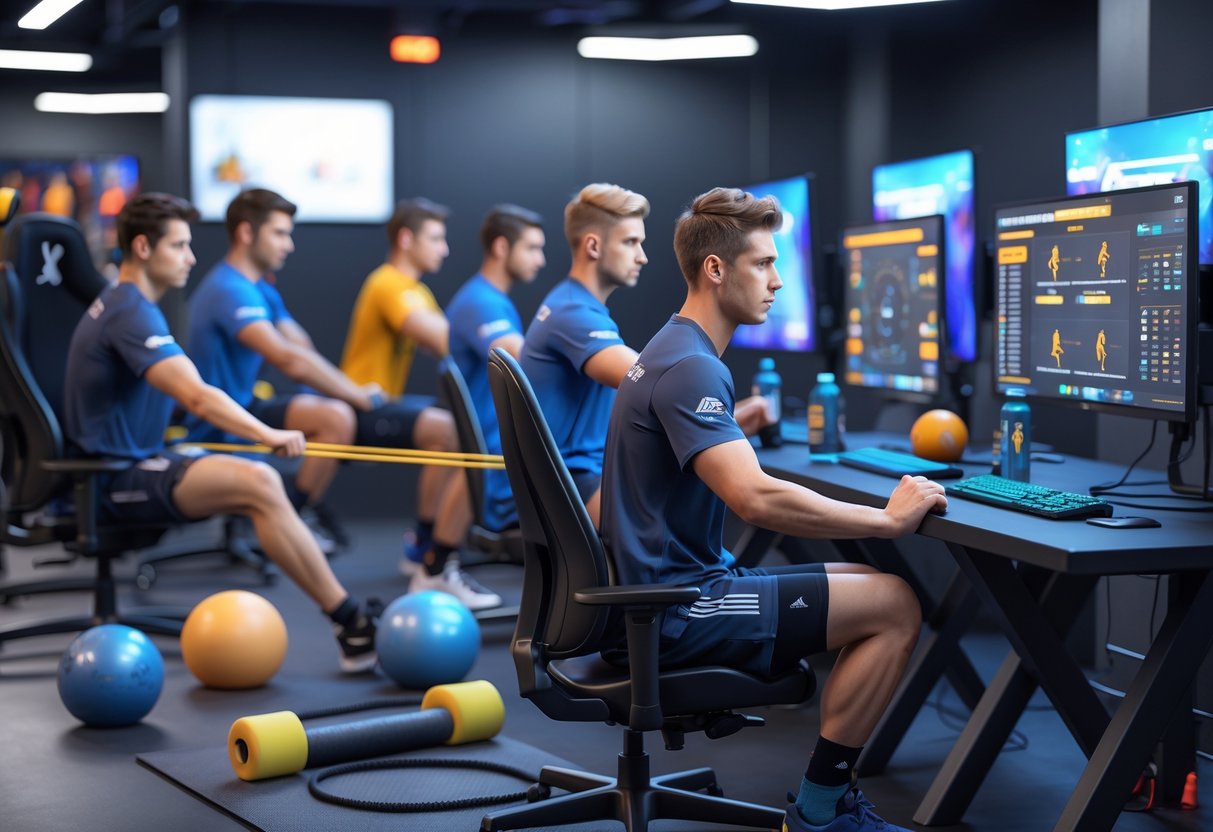
Physical exercise isn’t just for traditional athletes. Esports players need it to dodge wrist pain, neck strain, and other common injuries.
Strength training shores up weak muscles from all that sitting. Even just moving around every day helps break up those long gaming sessions.
Importance of Physical Exercises
Esports athletes have their own set of health risks. Hours in the same position lead to repetitive strain, bad posture, and weak muscles.
Exercise fights back against those problems. Stronger muscles support your body, and stretching keeps you from getting tight.
Regular exercise benefits include:
- Stronger back and core muscles
- Better wrist and hand flexibility
- Improved blood flow to prevent stiffness
- Less eye strain from staring at screens
Aaron Connolly, a gaming expert, says players who exercise regularly don’t just get hurt less—they can play longer without discomfort.
Aim for 30 minutes of physical activity each day. You don’t have to do it all at once.
Quick win: Take a six-minute active break every hour you game. Walk, stretch your arms, or just do some jumping jacks.
Recommended Strength Training
Strength training helps fix muscle imbalances from gaming. Focus on exercises that work the muscles you don’t use as much while gaming.
Essential exercises for gamers:
| Exercise | Target Area | Sets/Reps |
|---|---|---|
| Wall push-ups | Chest and shoulders | 2 sets of 10-15 |
| Band pull-aparts | Upper back | 2 sets of 15-20 |
| Wrist flexor stretches | Forearms | Hold 30 seconds each |
| Cat-cow stretches | Spine mobility | 2 sets of 10 |
| Glute bridges | Lower back/glutes | 2 sets of 12-15 |
Start with just your bodyweight. You’ll probably notice a difference in two or three weeks.
Warning: Always warm up before strength training. Cold muscles get hurt more easily.
Resistance bands are perfect for gaming setups. They’re cheap and barely take up any space.
Incorporating Physical Activity into Daily Routine
Building an exercise habit isn’t easy. Start small and work activities into your gaming schedule.
Daily routine suggestions:
- Morning: 10-minute walk or light stretching
- Pre-gaming: 5-minute warm-up routine
- Gaming breaks: Stand and move every hour
- Post-gaming: Cool-down stretches
Set reminders on your phone for movement breaks. Some gaming apps even remind you to take a break now.
Physical activities that fit gaming schedules:
- Desk stretches during queue times
- Balance board while watching esports streams
- Walking meetings for team calls
- Yoga videos between matches
Try tracking your movement with a fitness app. Shoot for 8,000 steps to start.
Quick win: Park a little farther away or take the stairs instead of the lift. These tiny changes add up.
Consistency beats intensity. Twenty minutes of movement every day is better than one big workout each week.
Stretching and Mobility Exercises
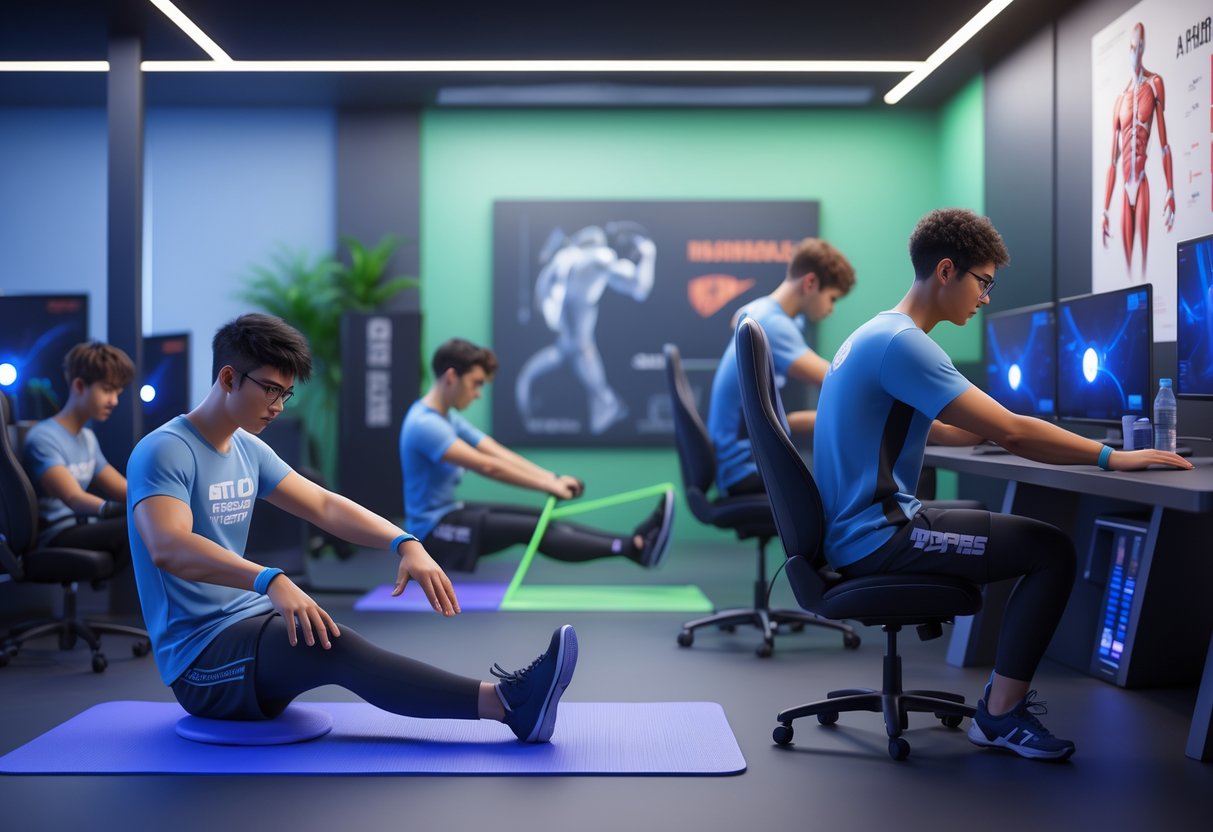
Regular stretching routines keep you safe from common gaming injuries like wrist strain and neck tension. Hand and wrist mobility exercises are especially important for keeping your fine motor skills sharp.
Stretching Exercises for Gamers
Long gaming sessions can leave you with tight shoulders, a stiff neck, and tense forearms. These stretches target those trouble spots.
Neck and Shoulder Relief
Start with gentle neck rotations. Turn your head slowly three times in each direction.
Do some shoulder blade squeezes next. Pull your shoulder blades together and hold for five seconds.
For deeper shoulder relief, try the doorway stretch. Put your forearm against a door frame at shoulder height and step forward until you feel a stretch.
Hip Flexor and Hamstring Stretches
Sitting too long tightens your hip flexors. The standing hip flexor stretch is great between matches—just step one foot forward into a lunge and push your hips forward.
For hamstrings, sit on the floor with one leg out. Reach toward your toes until you feel a stretch in the back of your thigh.
Quick Gaming Breaks
Try to do these stretches every hour if you’re gaming for a while. Hold each stretch for 20-30 seconds. Don’t force it—gentle tension is enough.
Hand and Wrist Mobility Routines
Your hands and wrists take a beating from gaming stress. These exercises keep them mobile and help prevent repetitive strain injuries.
Wrist Circles and Extensions
Start with wrist circles. Hold your arm out, palm up, and make slow circles—three in each direction.
For wrist extensions, hold your arm straight. Point your fingers down and gently pull your hand back with your other hand for 15 seconds. Then point your fingers up and pull forward.
Finger Strengthening
Gaming works your flexors a lot but not your extensors. To balance things, spread your fingers wide and hold for five seconds. Do this ten times.
Try the prayer stretch for deeper relief. Press your palms together in front of your chest and lower your hands until you feel a stretch in your forearms.
Daily Routine Timing
Do these exercises twice a day—once before gaming, once after. Morning stretches get your hands ready for action. Evening stretches help keep you from getting stiff overnight.
Breaks and Gaming Session Management
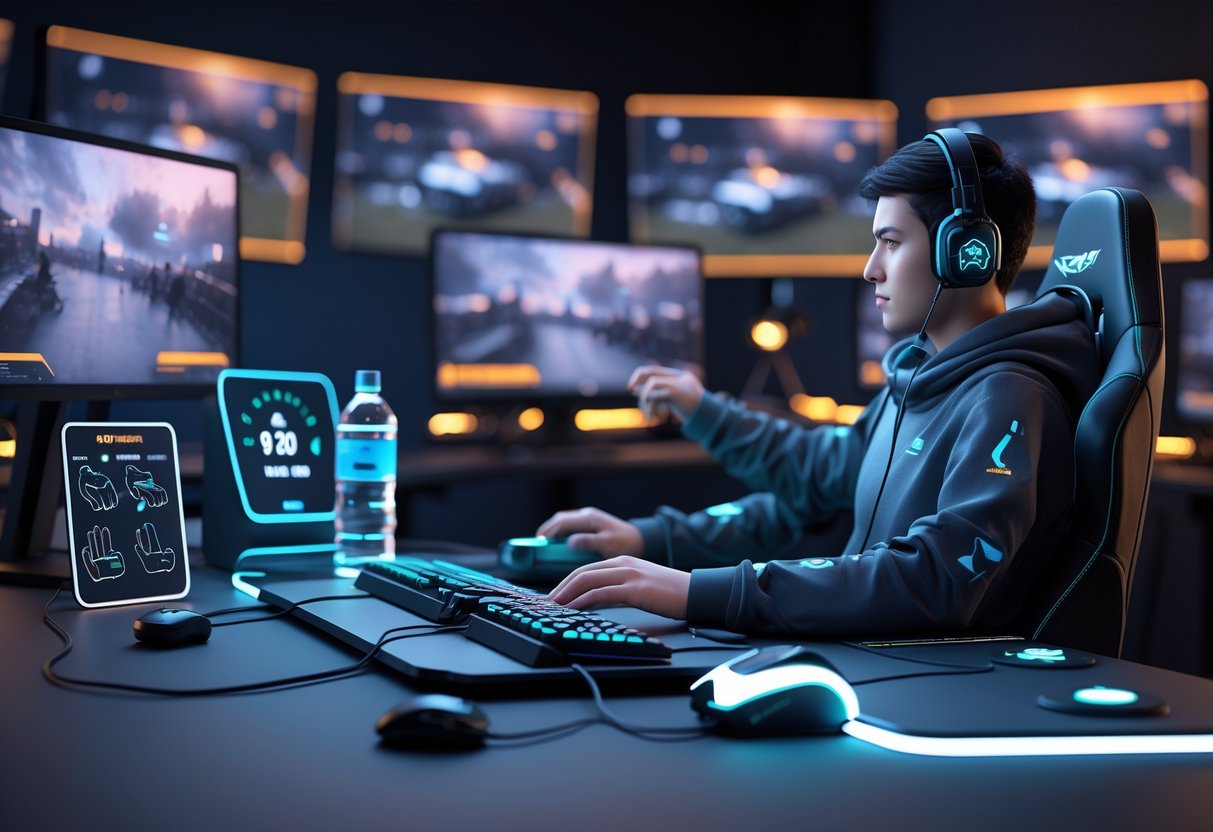
Taking breaks and managing your gaming sessions are honestly some of the best ways to dodge overuse injuries. Just a simple six-minute break every hour can protect your hands, wrists, and neck—and even sharpen your focus.
Value of Regular Breaks
Take a six-minute active break every hour you play. This isn’t just a suggestion—research backs it up. Regular breaks boost your mind and your body.
What makes an effective break:
- Stand up and move around
- Do some light stretches
- Look away from your screen to rest your eyes
- Take a few deep breaths
During breaks, move the parts of your body that stay locked up while you game. Roll your shoulders, stretch your neck, and flex your fingers and wrists.
Quick win: Set a timer on your phone for every 50 minutes. When it goes off, just take your break—don’t wait for “one more game.”
Your muscles need this downtime. If you keep your hands and wrists in the same position for hours, you’re just asking for trouble.
Managing Gaming Time to Prevent Overuse
Long, unbroken gaming sessions put you at the highest risk for injuries. We see players grind through eight or even twelve hours, which is just brutal on the body.
Effective session management strategies:
| Session Length | Break Frequency | Activities During Breaks |
|---|---|---|
| 2-4 hours | Every 50 minutes | Light stretching, walk around |
| 4-6 hours | Every 45 minutes | Active movement, eye rest |
| 6+ hours | Every 30 minutes | Full body movement, longer breaks |
Warning: Marathon sessions right before tournaments actually make injuries more likely. Like any athlete, you should taper your training before big events.
Plan your longest practice sessions for the middle of the week, not right before competition. Your body needs time to recover.
Try splitting long sessions into two shorter blocks. Take a 30-60 minute break between them to let your muscles reset.
Don’t forget about nutrition, hydration, and sleep between sessions. These are all essential for keeping your body at its best.
Physical Therapy and Rehabilitation

Physical therapists have become a crucial part of the esports world. They help players recover from wrist pain, neck strain, and other common injuries.
With the right rehab, players can get back to competing faster—and avoid future injuries.
Role of Physical Therapy in Esports
Sports medicine experts know esports athletes face their own set of challenges. Unlike traditional athletes, esports players rely on fine motor skills and sharp hand-eye coordination.
Physical therapists step in to help with all sorts of issues. They check for posture problems after long gaming sessions. Lots of players develop rounded shoulders and forward head posture from bad desk setups.
Upper extremity injuries are everywhere. Tennis elbow, golfer’s elbow, and finger irritation from endless clicking all need attention.
Physical therapists also focus on your workspace. Adjusting monitor height and chair position can make a huge difference right away. They even help with eye strain, since your vision is a big part of performance.
A licensed therapist will build a custom plan for you. They’ll treat your injuries and help you get fitter overall, which is important for anyone who spends hours at a desk. Regular exercise helps counteract all that sitting.
Rehabilitation Strategies for Common Injuries
If you’ve dealt with wrist and forearm injuries, you know targeted exercises make a difference. Gentle stretches can ease tension in tired muscles. Building strength in the area gives those vulnerable joints some real support.
Physical therapists usually take a hands-on approach:
- They use manual therapy to boost joint mobility.
- They prescribe specific exercises for the muscles you actually use.
- They’ll walk you through proper gaming posture.
- Sometimes, they’ll even check out your gaming setup for ergonomic issues.
Recovery timelines depend on how bad the injury is. If it’s just a minor wrist strain, you might bounce back in 2-3 weeks with care. But if you’re dealing with something like severe tendinitis, you could need 6-8 weeks.
Don’t overlook prevention. Regular breaks every 30-45 minutes during practice can really help. Toss in some simple stretches between matches to stay flexible.
Physical therapists look at the whole body, not just your hands. Core exercises help your posture during those marathon gaming sessions. Cardio matters too—it keeps your focus sharp during tournaments.
If you catch issues early, you’ll recover much faster. Players who get help at the first sign of pain usually bounce back quickly, compared to those who tough it out and hope for the best.
Mental Health and Psychological Stress
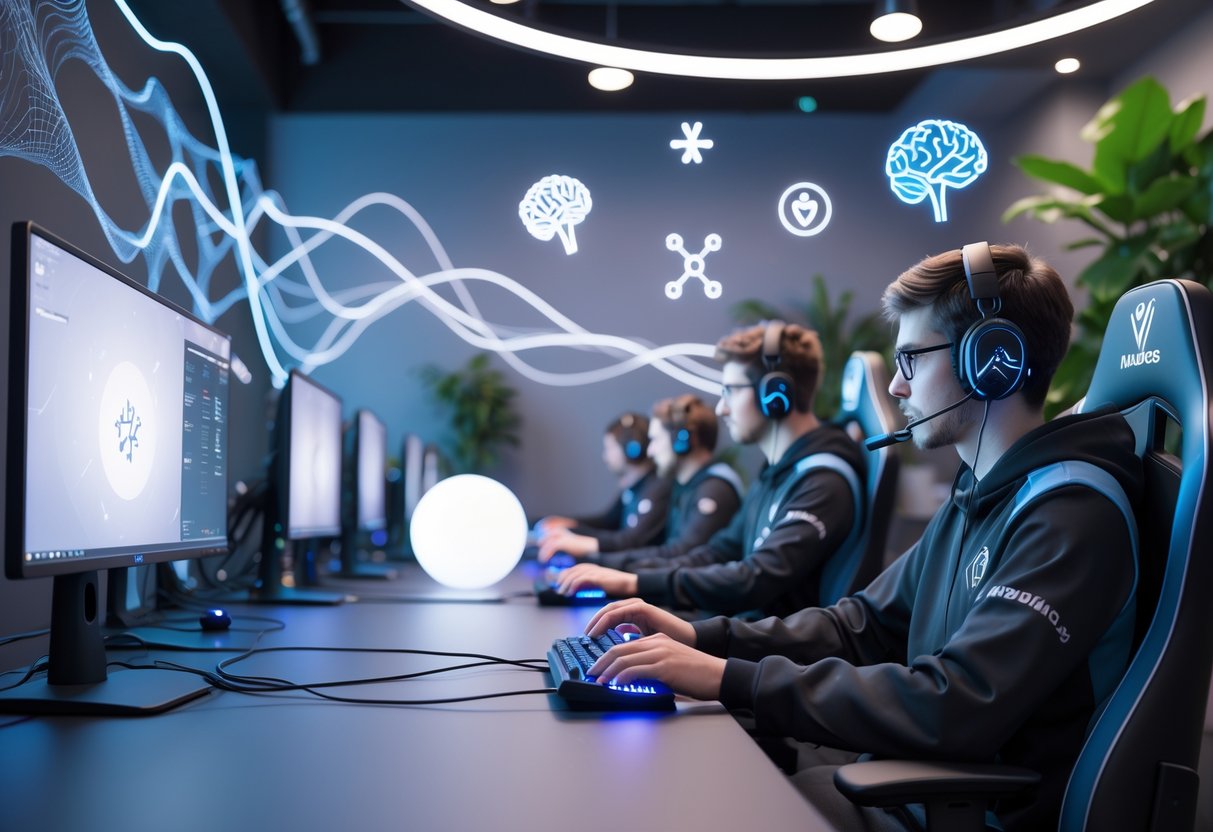
Esports athletes run into mental health challenges that go way beyond sore wrists. The pressure to compete can get intense—burnout, anxiety, and even gaming addiction sneak up if you don’t keep an eye out.
Psychological Stress in Competitive Gaming
Competitive esports piles on a unique kind of stress that’s different from traditional sports. Performance pressure really ramps up during tournaments, especially when thousands are watching you online.
And then there’s social media. Players face public criticism after losses, and toxic comments from fans can stick with you for a while.
Researchers have found that esports athletes deal with stress from all sides:
- Team conflicts and breakdowns in communication
- Defeat anxiety before big matches
- Time pressure during high-stakes games
- Public perception and the constant glare of media
Sleep disorders hit up to 60% of pro players. Late-night practice and unpredictable tournament schedules throw off your sleep.
Honestly, a lot of players just ignore early stress signs until it’s too late and they burn out.
Studies point out that mastery coping strategies work better than just trying to hide from the pressure. If you focus on getting better instead of running from stress, your mental health tends to hold up.
Effects of Gaming Addiction
Gaming addiction can seriously mess with your mental health if you’re in the esports scene. Sometimes, it’s hard to tell where healthy practice ends and compulsive behaviour starts.
Key warning signs look like this:
- Grinding for 12+ hours a day even when there’s no tournament
- Skipping meals and forgetting about basic hygiene
- Pulling away from friends and family
- Feeling anxious if you’re not gaming
University esports programs have found that addiction rates are even higher in competitive gaming than in casual play. The pressure to win can push players into unhealthy routines.
Physical symptoms pile on. Headaches, eye strain, and hand pain crop up after too much practice, and all that stress just gets worse.
Addiction doesn’t just hurt your body—it affects your decisions in-game. Tired players make bad calls, which leads to more practice, and the cycle keeps spinning.
Here’s a tip: Set daily practice limits and actually stick to them, even if you’re training hard.
These days, pro teams keep an eye on how much their players game outside official practice. That way, they can spot addiction problems before things get out of hand.
Holistic Approaches to Player Wellbeing
Modern esports organisations focus on mental health from every angle. Sports psychologists, nutritionists, and wellness coaches work together now.
Mental toughness training helps players handle the pressure. Techniques borrowed from traditional sports—like visualisation and breathing exercises—fit right into esports.
Effective wellbeing programs offer:
- Regular mental health check-ins with professionals
- Workshops on stress management and coping strategies
- Education about sleep hygiene for better rest
- Social support networks so players don’t feel alone
Teams now schedule mandatory breaks between practices. That keeps mental fatigue in check and helps players stay sharp when it counts.
Nutrition support matters too. What you eat affects your focus and reaction time. Too many players just live on energy drinks and junk food during training.
Some organisations even bring in on-site counsellors. Players can talk about stress privately, without worrying about losing their spot on the team.
Honestly, the best teams treat mental health as seriously as mechanical skill.
Players with strong support systems tend to perform more consistently. They report being happier with their careers and stick around the scene longer.
Injury Prevention Strategies by Game Genre
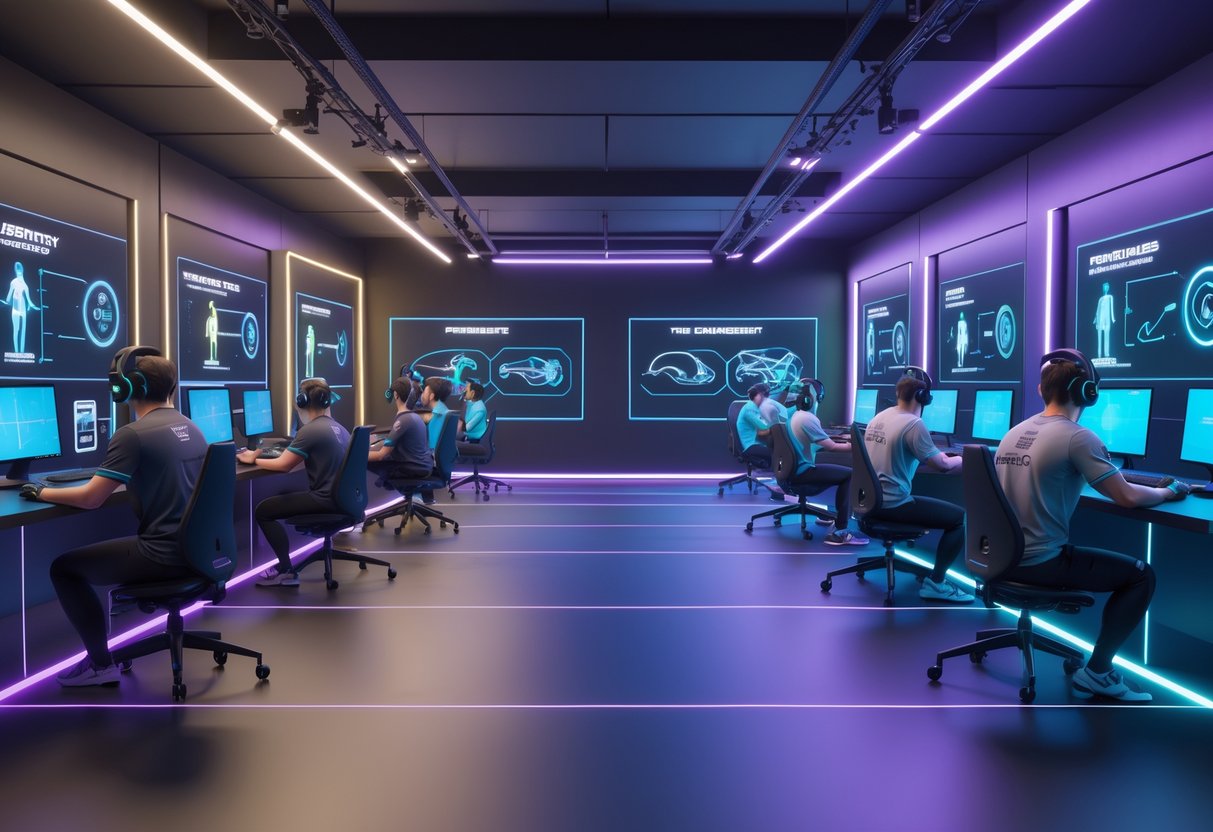
Different games push your body in different ways. MOBA and RTS titles each have their own movement patterns and stress points, so prevention strategies need to fit the genre.
MOBA, RTS and Genre-Specific Risk Factors
MOBA games like League of Legends and Dota 2 demand crazy finger coordination and relentless clicking. At peak moments, players can hit 300+ actions per minute.
All that mouse movement puts a ton of strain on your index and middle fingers. If you’re right-handed, you’ll notice muscle imbalances over time.
RTS titles like StarCraft II get even trickier. You’re juggling multiple unit groups and keeping an eye on the map at the same time.
To prevent injuries, try these:
- Finger extension exercises with resistance bands between games
- Switching grip styles during long sessions
- Keeping your wrists neutral to avoid carpal tunnel pressure
- Taking 5-minute breaks every half hour of intense play
Warm-ups for each genre should hit the muscle groups you use most. MOBA players need finger flexibility, while RTS players need a full hand and forearm routine.
Pro teams now work game-specific stretches into their daily training. These targeted routines help players handle the unique demands of each genre.
Optimising Performance Whilst Reducing Injury Risk
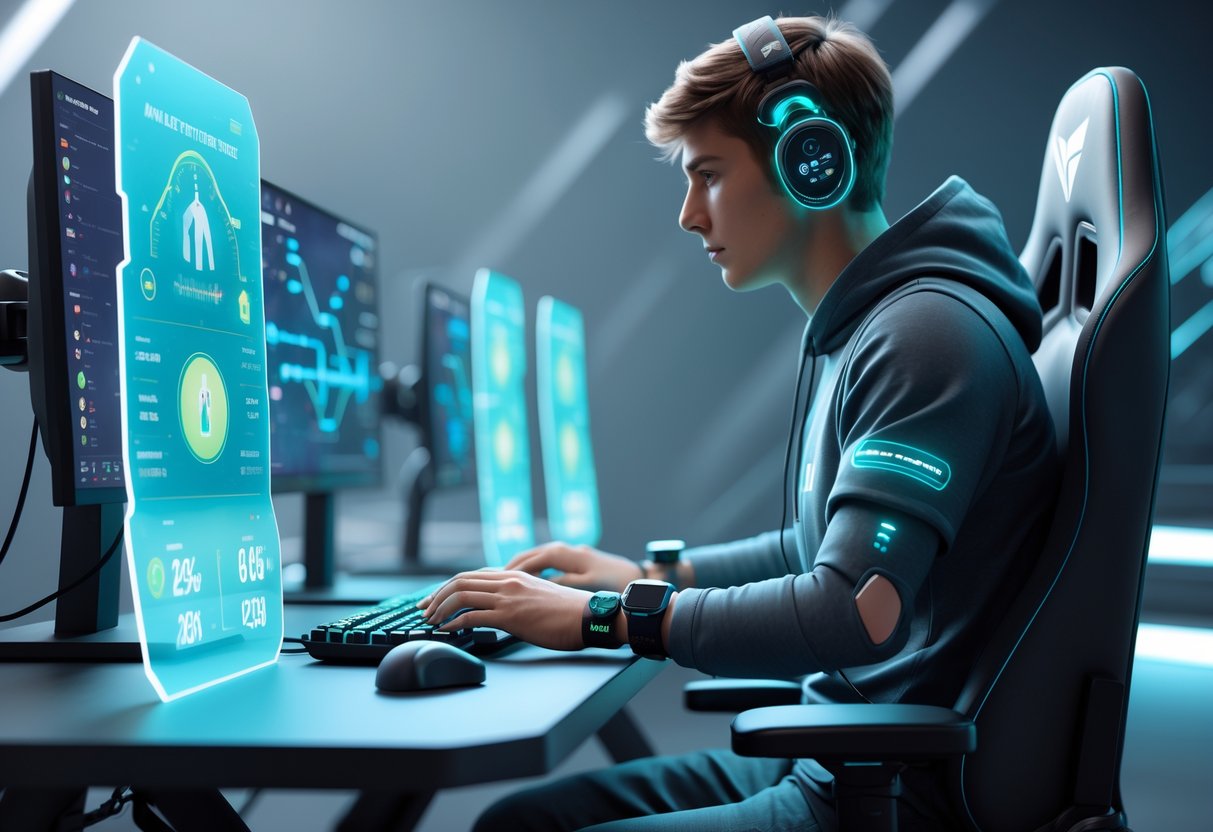
If you want to hit peak gaming performance and avoid injuries, you need smart training habits and good ergonomics. Pro players keep up 300+ actions per minute, but they also protect their bodies with the right exercises and gear.
Enhancing Gaming Performance Safely
Physical fitness really does affect reaction time and decision-making. Studies show that esports athletes who exercise regularly have better hand-eye coordination and stay focused longer.
Core exercises for gamers:
- Stretch your wrists and forearms every 20 minutes.
- Do neck rotations to fight forward head posture.
- Squeeze your shoulder blades together to strengthen your upper back.
- Stretch your hip flexors if you’ve been sitting too long.
Wearable sensors now track your posture and muscle strain in real time. These gadgets monitor your spine and send alerts if your position slips.
Equipment matters, too. Set your monitor at eye level to save your neck. Keep your keyboard and mouse at elbow height, with your elbows bent at 90 degrees. Pick a gaming chair that supports the curve in your lower back.
The 20/20/20 rule keeps your eyes fresh: every 20 minutes, look at something 20 feet away for 20 seconds. It’s simple but helps a lot.
Long-Term Health for Esports Careers
Most pro gaming careers last 5-8 years, so injury prevention is key if you want to stick around. Back pain hits over half of competitive players and can force early retirement.
Compensatory exercises help with common issues:
- Strengthen your posterior chain to fix bad posture.
- Do core stability work for spinal support.
- Train your grip to avoid repetitive strain.
- Keep up your cardio for mental sharpness.
Many pro teams now hire physiotherapists to design custom programs for each player. These focus on strengthening weak muscles and stretching overused ones.
Nutrition matters for performance and recovery. Esports athletes need between 1800 and 3000 calories a day, depending on their schedule. Cutting down on caffeine helps avoid heart problems that some players run into.
Regular health checks catch issues early. X-rays spot spine alignment problems, and ultrasounds can pick up tendon inflammation before it gets bad.
If you want to compete at your best, remember—your body is your number one tool.
Frequently Asked Questions
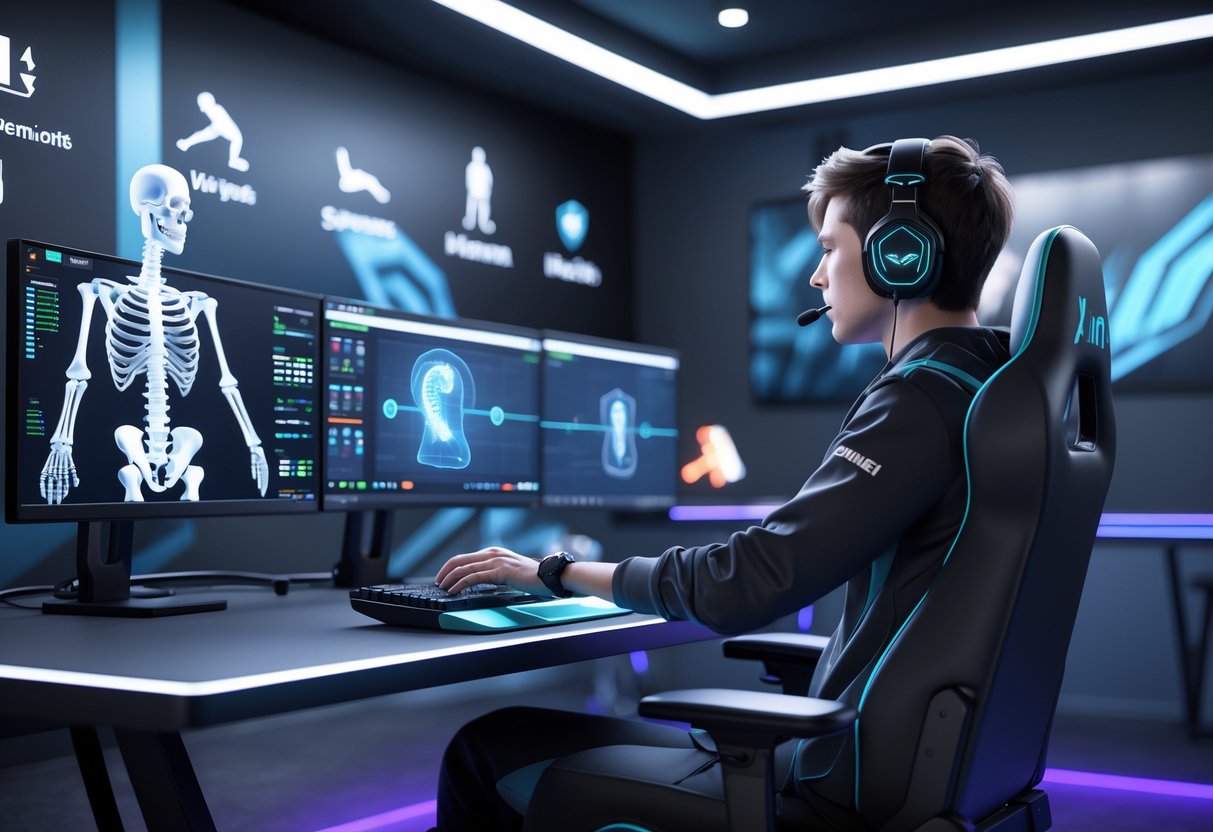
You can prevent most gaming injuries if you know what to do. Esports athletes often deal with neck pain, back problems, and eye strain from bad posture and long hours.
How can I maintain proper posture while gaming to prevent injuries?
Put your monitor at eye level to avoid neck pain. Keep the screen about an arm’s length away.
Sit with both feet flat on the floor. Try to keep your knees bent at a 90-degree angle.
Adjust your chair so your elbows rest naturally at your sides. Keep your wrists straight when you use the keyboard and mouse.
Take micro-breaks every 30 minutes. Even 30 seconds of standing up and stretching can help.
Quick win: Set a phone timer to remind yourself to check your posture while gaming.
What are the common types of injuries experienced by esports players?
Most competitive gamers run into neck and lower back pain from sitting hunched over for hours.
Eye strain tops the list of complaints. Dry eyes, blurry vision, and headaches are common.
Repetitive strain injuries hit wrists and fingers. They build up from constant clicking and typing.
Hand and wrist inflammation can cause real trouble if you ignore it. Pro gamers depend on their hands for a living.
Shoulder tension builds up from bad chair height or poor arm positioning. That pain can travel down your arms.
Could you suggest some ergonomic equipment essentials for a gaming setup?
Choose an adjustable gaming chair with good lumbar support. Expect to spend £150-300 for something that lasts.
Monitor arms let you set your screens at the perfect height. This saves your neck from craning.
A mechanical keyboard with light switches makes things easier on your fingers. Cherry MX switches are a solid choice.
Pick an ergonomic mouse that fits your hand and grip. If your wrists already hurt, try a vertical mouse.
A footrest helps if your desk is high—it keeps your legs in the right spot and your blood flowing.
Warning: Don’t buy cheap gaming chairs without proper back support. They usually cause more pain than they’re worth.
What exercises can help in preventing repetitive strain injuries for gamers?
Wrist circles and stretches keep your hands loose. Do them every hour during breaks.
Neck rolls help release tension from staring at screens. Roll your head gently both ways.
Shoulder blade squeezes fight that forward hunch. Hold your blades together for 10 seconds.
Finger extensions stretch out tight muscles from gripping controllers. Spread your fingers wide and hold.
Eye exercises cut down on digital eye strain. Look at something far away for 20 seconds every 20 minutes.
Quick win: Download a break reminder app to guide you through stretches between matches.
Can you explain the importance of breaks during gaming sessions for injury prevention?
Your muscles need to move regularly to stay healthy. Sitting still too long leads to tightness and poor blood flow.
The 20-20-20 rule protects your eyes from getting tired. Every 20 minutes, look at something 20 feet away for 20 seconds.
Mental fatigue slows your reactions and clouds your judgment. Short breaks actually help you play better.
Even 30-second micro-breaks help reset your posture. Stand up, roll your shoulders, and stretch your neck.
Take longer breaks every two hours. Walk around and do some light stretching.
Pro teams schedule mandatory breaks during practice. They know that healthy players perform best.
What role does physical therapy play in the recovery and prevention of esports injuries?
Physical therapists who focus on gaming injuries really get the unique demands of esports. They’ll come up with treatment plans that actually fit gamers’ needs.
If you catch problems early, you can stop minor aches from turning into bigger issues. With the right treatment, a lot of these problems clear up pretty fast.
Therapists use strengthening exercises to address weak muscles that mess with your posture. They put together programs just for gamers—no generic stuff.
You’ll also see them use manual therapy to loosen up tight muscles and stiff joints. That hands-on approach brings quick pain relief for a lot of players.
Therapists don’t just treat pain—they’ll teach you about good ergonomics too. They’ll look at your gaming setup and point out what you could tweak.
Quick win: Tons of physiotherapy clinics now offer esports injury checks. If you’re dealing with regular gaming pain, it might be time to book one.

